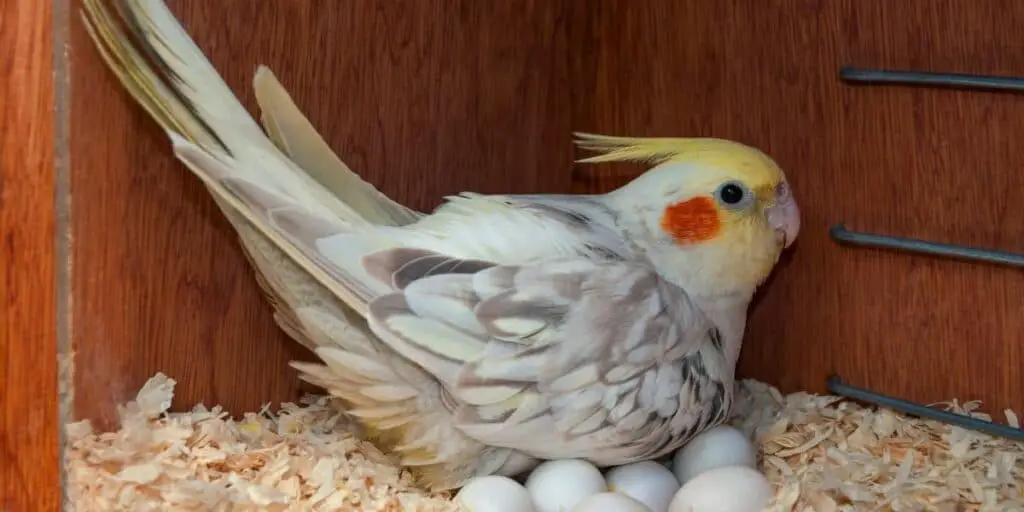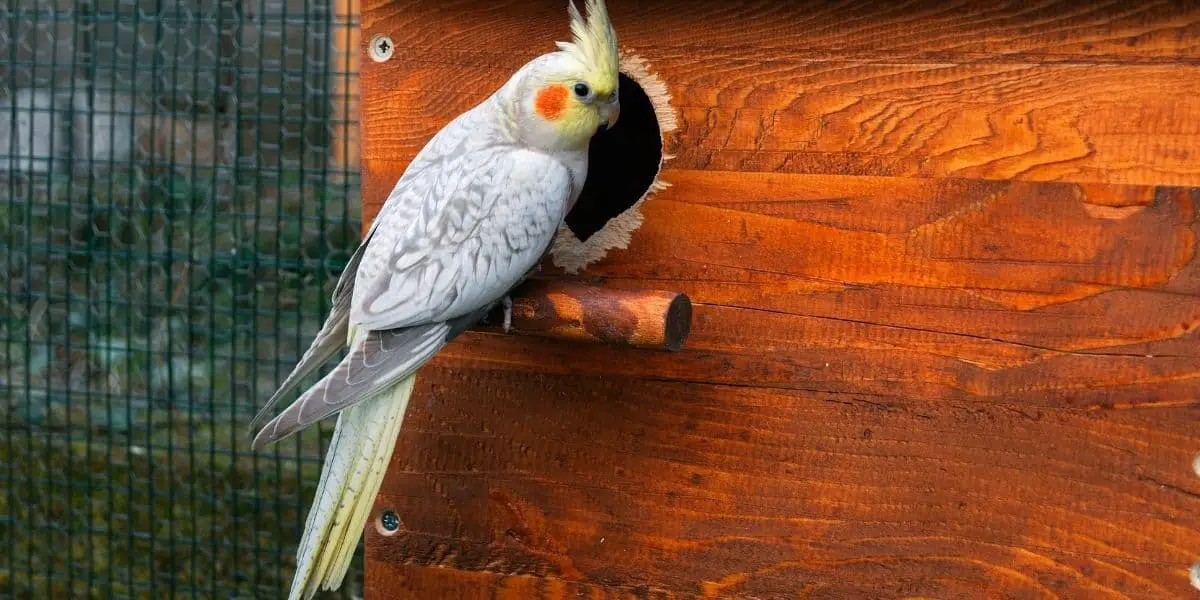The Cinnamon Pearl Cockatiel is named for its gorgeous and unique patterning and color. While Cockatiels were being bred as pets, a mutation that occurred, preventing their genes from creating gray or black. Instead, they are a lovely cinnamon-gray color!
Cinnamon Cockatiels are affectionate, friendly, and sweet. They can make great pets for any bird-lover and responsible pet-lover!
Table of Contents
What Do Cinnamon Pearl Cockatiels Look Like?
Their feathers are a very light, tannish cinnamon-brown (which can look quite similar to gray but is not technically gray), mixed with a great deal of yellow.
Some are known as Cinnamon-Pied Pearl Cockatiels, and these sport a striking, speckled pattern of cinnamon and yellow.
Perhaps the most noteworthy feature of the Cinnamon Pearl Cockatiel – and any Cockatiel – is its crest, however! All male and female Cockatiels sport a magnificent, feathery mohawk.
Cinnamon Pearl Cockatiels’ faces are a bright yellow, and the men have vibrant orange cheeks, while the females have cheeks that are a more muted peachy-orange color.
They are technically a type of parrot and have the classically curved parrot beak. While some Cockatiels may have gray or dark beaks, Cinnamon Pearl Cockatiels tend to have beaks that are pale tannish or light pink.
A Brief History of the Pet Cockatiel
The Cockatiel hails from the warm, green climes of Australia, filling the forests with its squawking, whistling calls and bright pastel color.
They were long admired for their beauty, and some even displayed friendliness that made them highly sought-after. They became known as pets in the 1900s, and since then, have only grown more popular.
The Cinnamon Pearl Cockatiel is actually a recessive strain, resulting from breeding the wild Gray Cockatiel. This prevents the brown genes from turning brown or black.
As a result, they naturally lack any of the Grey Cockatiel’s hallmark grey color!
What Do Cinnamon Pearl Cockatiels Sound Like?
Cinnamon Pearl Cockatiels are rather talkative and tend to chirp, warble, whistle, cheep, and more. With practice, like many parrots, they can even learn to talk!
Personality and Behavior
Cockatiels are gregarious and friendly birds, both with familiar humans, and each other! This makes them an excellent companion animal. In fact, Cockatiels bond deeply with their humans, and they require plenty of interaction in order to feel happy.
Otherwise, tragically, loneliness is a serious risk. Although birds are definitely individuals, Cinnamon Cockatiels (and Cockatiels of all kinds) tend to enjoy cuddling, being held, petted, etc.
So, they may be a good choice, if a highly affectionate pet is what you’re after.
Cockatiels are actually less demanding and hyperactive than some types of parrots can be, earning them a reputation for being exceptionally good-natured and mellow (they still get lonely without company, however).

Cinnamon Pearl Cockatiels are also quite chatty, silly, and playful. They can spend quite a while playing with their toys, making sounds, and of course, vying for attention from their beloved owners.
These characters have also been known to become quite enamoured with their reflection in the mirror!
Bonding With Your Cockatiel
The best way to bond with your Cockatiel is to chat with it. Before making it get out of its cage and come hang out with you, make sure it knows that you’re not a predator.
Treats are also a fantastic way to gradually win them over. Offer toys, be kind, and be patient; birds are sensitive, and it may take a while before you’ve won their trust. Once you truly have, they will be loyal to you forever!
How Long Do Cockatiels Live?
In the wild, cockatiels are said to live 10-15 years. Some, particularly in captivity, have been known to live more like 15-25 years, and even 30 is not unheard of.
What counts when it comes to the longevity of any animal, besides lucky genetics, of course, is the proper care. When they are hygienic, well-fed, loved, and happy, Cinnamon Cockatiels will live significantly longer.
The Ideal Habitat for a Pet Cockatiel
The most important thing for any bird is plenty of space. The trust is, no cage will compare to the sky, but it should at least be made as pleasant as possible.
Here is the cage we recommend!
This means that the bigger the better. Since captive Cockatiels are safer, with steady access to food, it’s a trade-off. Your Cinnamon Pearl Cockatiel should have a cage that is no less than double their wingspan, ideally more.
Make sure to include plenty of perches and toys for stimulation; Cockatiels are used to plenty to do out in nature, so toys to entertain them will keep them a lot happier!
When placing perches, just take care to keep them away from the food and water, which fallen droppings could taint, potentially making your bird sick!
What Should You Feed a Cinnamon Pearl Cockatiel?
You should feed your Cinnamon Cockatiel pretty much the way you’d feed any other Cockatiel. Their coloration may be unique, but their diet does not differ.
In the wild, Cockatiels eat mostly seeds and fruit and have even been known to raid farmer’s crops for berries, corn, apples, whatever they can fit in their beak.
A pet Cinnamon Pearl Cockatiel will need to be fed a balanced diet of 25% seeds and 75% pellets, and fruit is their all-time favorite snack.
Cockatiels can have mangos, melons, kiwis, apples, and most fruit. Carrots, broccoli, corn on the cob, and many veggies are also OK. Just make sure to always remove the seeds or pits, as these are a potential poisoning or choking risk.
Socializing and Breeding Your Cockatiel
Cockatiels typically get along quite well with their own kind and actually prefer the company of another Cockatiel (or three). This is a bird that can be left by itself for a little while each day – provided it has a Cockatiel companion to keep loneliness in check.
Like many animals, male and female Cockatiels will often breed when they are kept together. This being said, they will have to be compatible in order to become a pair. Otherwise, they are almost certain to fight, and will at best ignore each other!
Cockatiels can be quite affectionate with their mates. They can often be seen grooming, kissing, or feeding each other. Before they consummate their relationship, the male does a mating dance, while the female admires the show!
What Are Cinnamon Pearl Cockatiel Young Like?
Baby Cinnamon Pearl Cockatiels are light in color, usually yellow. They have soft, downy feathers, and big heads that wobble on their necks. For the first day or so, they are unable to stand or walk.
Before they hatch, the male and female Cockatiel take turns serving as an incubator. Once they are born, the young are generally well-loved and closely cared-for.

Proper Hygiene for the Cinnamon Pearl Cockatiel
You will need to clean your Cockatiel cage at least once a week. This will help keep nasty smells and diseases in check. Along with this, frequently check and refresh the water bowl. Perishable food should be removed if there is any leftover.
To clean a Cockatiel cage, simply empty it and scrub it out with a scrub brush (specifically for this purpose), dish detergent, and water. Then, place it in a disinfectant, such as bleach, for 15 minutes, to soak. Finally, rinse and dry the cage off.
Pets and Other Dangers to Consider
When choosing a location for your Cinnamon Pearl Cockatiel cage, you’ll want to consider pets as a potential danger. Cats and even dogs may choose to try to turn your Cinnamon Pearl Cockatiel into a snack.
Not only this, you’ll need to choose somewhere that people pass through a lot, but which is not excessively loud. Avoid any room with a TV.
Also keep your bird away from smoke, drafts, and other environmental factors that could prove a health risk.
As you can see, Cockatiels are beautiful, lovable birds, and it’s no surprise that they are so popular. They are long-lived, sociable, good-natured, silly, and loyal. In a pet bird, what more can you ask for?




